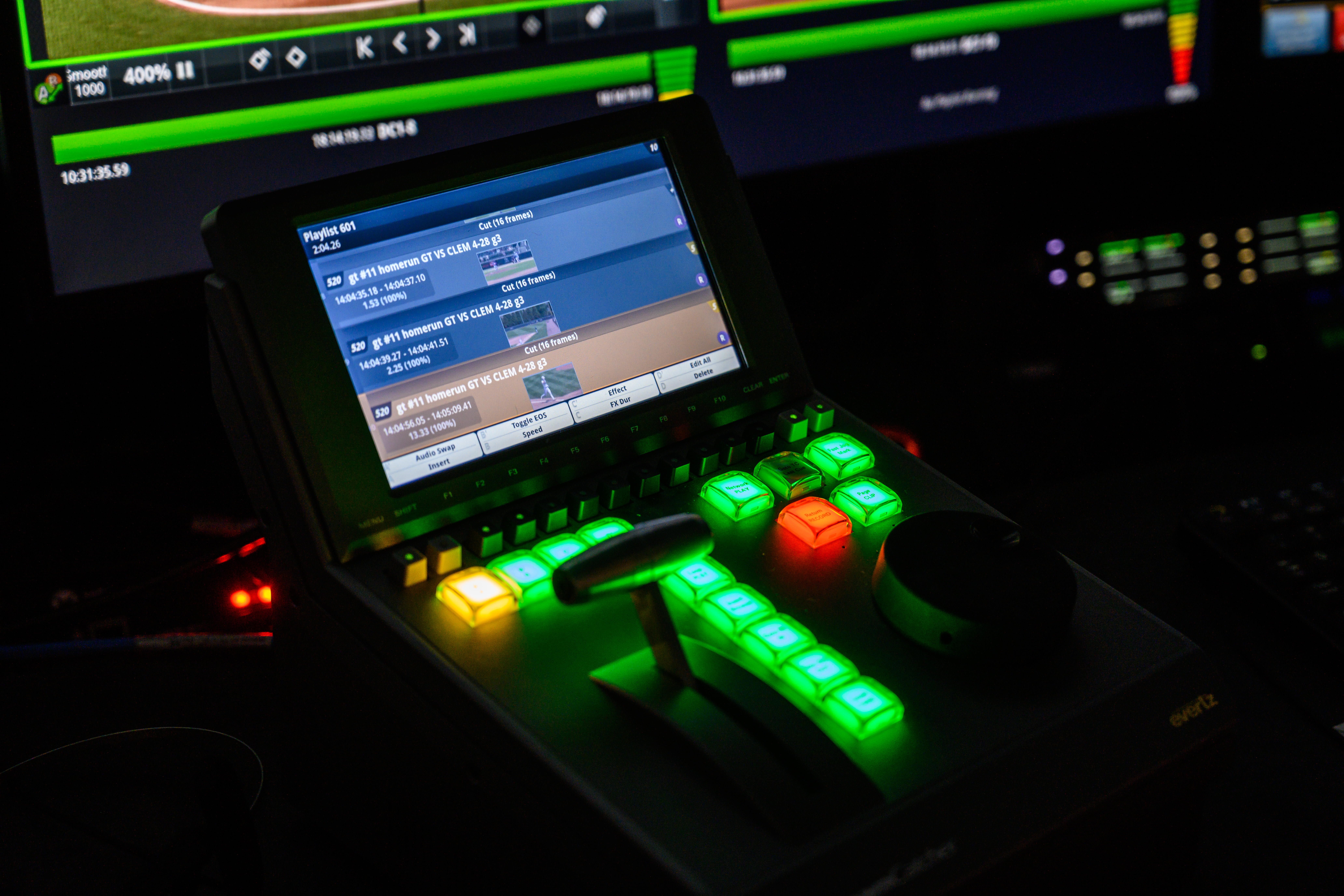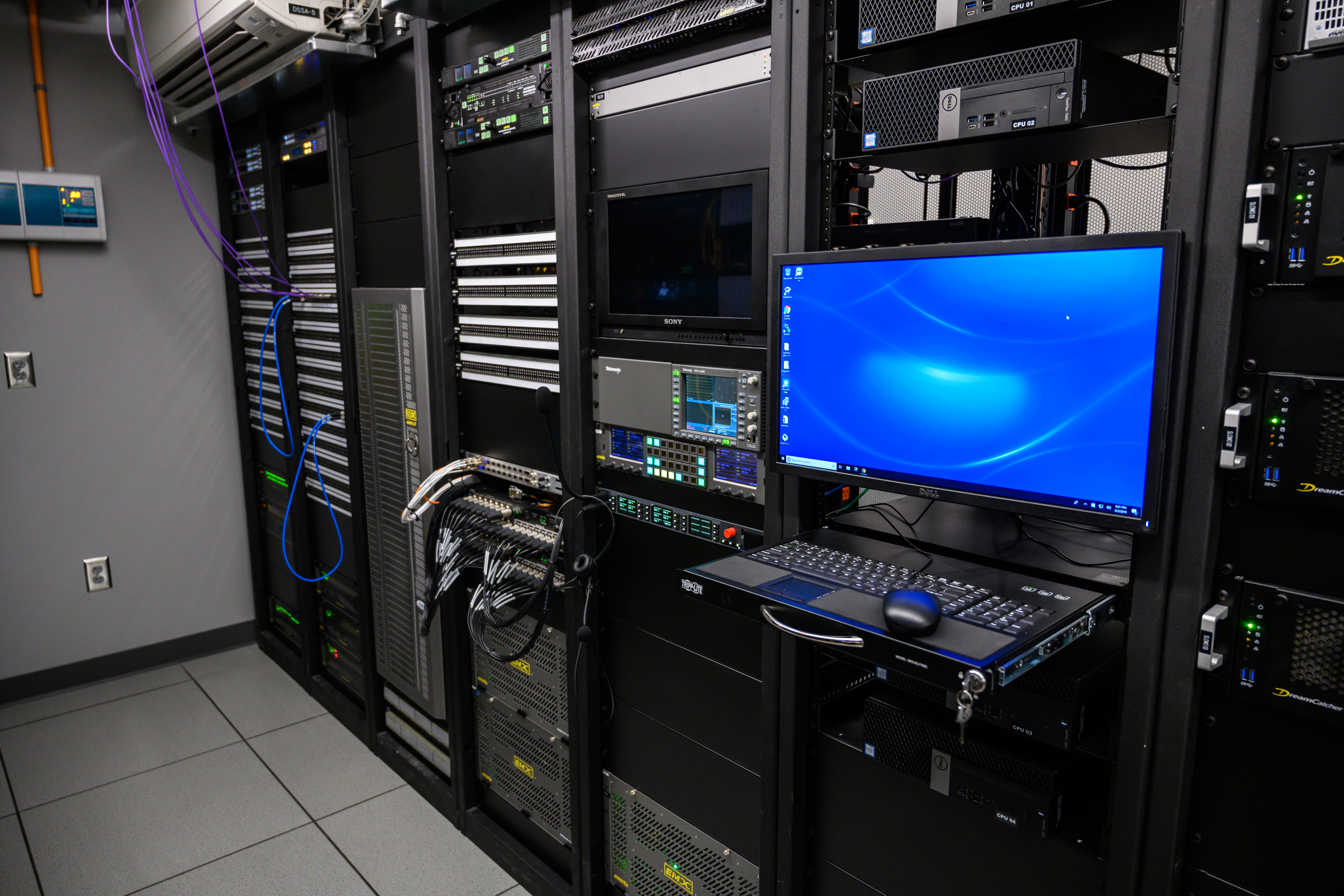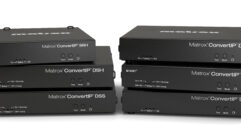 On this edition of the SVC Podcast, Contributing Editor Bennett Liles continues his interview with Jeff Volk, Vice President at Alpha Video concerning their installation of a new sports television production center at the Georgia Institute of Technology. The new facility connects sports venues around the Georgia Tech campus on fiber optic links. Multiple programs can be assembled and sports events covered live simultaneously in the new broadcast center. In Part 2 Jeff discusses the intercom system, facility staffing and crew training.
On this edition of the SVC Podcast, Contributing Editor Bennett Liles continues his interview with Jeff Volk, Vice President at Alpha Video concerning their installation of a new sports television production center at the Georgia Institute of Technology. The new facility connects sports venues around the Georgia Tech campus on fiber optic links. Multiple programs can be assembled and sports events covered live simultaneously in the new broadcast center. In Part 2 Jeff discusses the intercom system, facility staffing and crew training.
FOR MORE: FOR PART 1
Links:
- Alpha Video and Audio, Inc. – national AV and broadcast integrator
- Evertz DreamCatcher Production Suite
- Ross Video Xpression
- Riedel Communications intercom system
ESPN’s new Atlantic Coast Conference TV sports network showcases the ACC teams and Georgia Tech is at the top of it with their new ACC network broadcast facility. Alpha Video’s Jeff Volk is back to wrap up the story on how they got it all up and running within budget. That’s right here on the SVC Podcast.
Jeff, good to have you back with us for Part 2 on the SVC Podcast from Alpha Video. We were talking about the new ACC network athletics video production facility that you installed at Georgia Tech. Alpha Video has a lot of experience at control rooms. This was a massive project and very mission critical high profile stuff. The central part of the facility has to be the routing switcher. So how does the routing work there? If that goes down, you’re toast.
Yeah, absolutely. So anytime that you’re working on a project of this type obviously the routing system is the heart of that, right? So without a robust video and audio routing solution it makes the facility just not go, right? It’s the heart of everything you do. For this project we deployed a very large enterprise-grade video routing and audio routing solution from Evertz. We sort of, along with many other integrators in the industry, have sort of a standardized way that we handle wiring routers. And so not only do we have the routing switcher itself, but to add even further flexibility as well as some redundancy should the router fail, is we also use a series of patch panels on the input and output side of the router. So should there be a catastrophic router failure we can patch around the router and still keep a program on air. So between the patching and the large Evertz routing core we have not only enough routing capacity to handle all of the signals that they need today – forgive me, I don’t have the exact number off the top of my head, but it’s in the several hundred inputs by several hundred outputs category. And I think it’s ultimately expandable to around 512 inputs by 512 outputs on the video side. Audio with MADI and the way that we’re handling those bridges to Dante it can have even more signals but it’s roughly in the same ballpark, same domain, in terms of stereo audio inputs and outputs. So it’s a rather massive solution when we manage redundancy. From the hardware perspective that’s just the physical connectivity. We also have a whole control layer using Evertz Magnum Suite, a software to control the thing. That does have a full redundant software system so we have a primary control system that controls the router and then we have a fully redundant backup system that also can control the router and failover should the primary system go down. So through a good amount of planning and sort of some standard engineering practices we think we’ve been able to provide them a core that not only allows them all of the things that they need to do today, but that ultimately leaves them the room for expansion and gives them that piece of mind in terms of this thing should run pretty rock solid and should we have some sort of a weird anomaly or catastrophic failure we’ve built in enough fail safes to allow them to at least likely stay on the air. [Timestamp: 3:35]
All about failovers and backups. These are live sports events so there are no take-twos.
Absolutely.
You’ve got to be ready to go. So obviously a lot of this is about recording. They have to get the video and sound recorded and edited very quickly. How is all of the programming and production recorded there?
So there’s a couple of different ways that we handle that. Obviously there’s all of the camera feeds and those are coming in to replay systems and a number of digital recorders that allow them to be replayed for slow-mo and the other applications in real time. So we have that level of recording. And then there’s a whole highlights management system that allows Georgia Tech to take any of the camera feeds or video feeds that are recorded onto their slow motion replay systems and push those off into an editorial system, so storage that their editors can then use later to repurpose that content. We also have some dedicated recording devices that allow them to either record ISO’s of any feed that they want. They can record the complete program so they can record their complete television broadcast. They can record their complete video board broadcast and then those files are pretty much 100 percent immediately ready to be edited should they need to add further editing to them. And there’s the whole editorial layer that they had existing that we’re just connecting into that allows their editors and edit work stations to connect to that storage. Then we’re just pushing files from the new production environment over to that edit storage to allow them to edit it. So again, it’s just a matter of planning. That’s one area where we repurposed a fair amount of stuff that they already had from an editing perspective. And because that was relatively new and things that we could reuse and repurpose without a need for replacement. As we looked to balance budget once again and do some value engineering, those were some areas that we took out. But they have multiple ways to record, multiple ways to get different video elements to their editors to edit them, multiple ways to get any of those highlights or any of those packages either on the internet or over the air or sent off to their marketing partners, TV partners, you name it. So we designed a pretty robust back end to allow them to record and distribute just about anything that they want. [Timestamp: 5:58]

And when you were going through the selection process on the hardware did you have equipment demos, people bringing things in and running it for you?
We did. So we did really two different layers of demonstrations. And Georgia Tech, to their credit, had been doing some planning on this even before they brought us on board. So they had sought out some manufacturers to come in and do some demonstrations for them prior to even us getting on board. They had been very diligent about doing their research and having a clear understanding of what they wanted. But once we were on board we used some tradeshow events, like NAB, to verify some ideas about equipment and sort of pare down the manufacturers to the folks that we thought might work best for the particular project. And then even after that, for some specific areas like the production cameras and the replay system we did host some shootouts and have some people come in and provide demos of various different solutions. We really took the opportunity to pair those two things together. And so we did the camera shootout at their baseball stadium during a day that they had some fall baseball practice happening. We had some replay things that we did there so that we could really tie the two together and see how the camera to the replay system workflow would look like. There’s some cool things that we’re doing on the camera side with high frame rate to provide some super slow-mo. And there’s some other things that we have built into the system to allow them to provide some things that are really stuff that you would expect from higher-end productions that you might see for the NFL or Major League Baseball. And so understanding what some of those things looked like in real-world terms balanced versus what they cost was a very important part of the process again as we tried to get the wish list down to match the budget. And so absolutely we did a number of equipment demos and then settled upon final vendors after those demos and then really used those selections to then go and negotiate final pricing based on what we then believed would be the quantity. So like 13 Panasonic camera packages, for example. [Timestamp: 8:13]
And one of the other critical components on this thing, probably second only to the routing system is the intercom system because you could have smooth operation or chaos or anything in between depending on how that’s set up.
Yeah, absolutely. You’re 100 percent correct. So communications is often something that can be overlooked at times and not as much budget assigned to it as maybe should be. That is not the case at Georgia Tech. So we have not only a very robust wired intercom solution – and we settled on Riedel intercom solution for this project. There’s a very large wired intercom matrix that allows us to isolate the four control room spaces as individual spaces. We can combine them. We have an ultimate amount of flexibility in how we handle communications within the production facility itself. We extend that wired communication out to some of the venues, but then we are also using Riedel’s Bolero system to provide wireless communication attached to the main intercom matrix at all of the venues themselves. So some venues, such as football, have rather extensive wireless intercom deployments in addition to all of the wired intercom stuff that we have. So we’ve made a large network of wireless antennas across venues, across campus that allow them to take belt packs out and use the intercom wirelessly and connect back to the control room. The nice thing about the Bolero system is that the wireless belt packs aren’t just necessarily little wireless intercom belt packs. They’re almost like little mini full working matrix intercom stations that you would find back in the control room. So from a flexibility and an ease-of-use and really being able to repurpose quickly the equipment for all of the various different production scenarios that Georgia Tech or really any of the ACC schools that are doing productions for the network have, it’s critical and really eases the overall operation of the system. [Timestamp: 10:19]

You got all of that equipment in there and installed. They started using it. Once they began operation did they call Alpha Video back in to make any tweaks on anything?
Yeah, so we were finished in March of last year preliminarily and then used the system immediately to produce some baseball games that went out on ESPN on the digital side. And over the course of those events as well as just sort of using the system and fleshing it out over the course of the summer we absolutely made a bunch of tweaks. So with any system and undertaking of this size there’s the technical piece of how components go together, and that’s pretty easy, right, because there’s only so many different ways that I can wire one thing to another thing. So that piece of it usually goes pretty easy. The part that usually requires the tweaks and the changes after the fact is the user experience. So a router control panel or an intercom control panel, for example, there’s a multitude of ways that I can program those to operate and that is usually determined a little bit by best practice, but also 100 percent by user preference. And so some users have a preference to want it to be X, other users have a preference to want it to be Y. And with Georgia Tech’s facility or any of the ACC network or SCC network facilities they not only have the preferences of how their internal staff prefers to work but if they’re producing a linear event that’s going on one of the ESPN family of cable or satellite distributed networks and not just on the internet, ESPN actually brings in some production crew for that, like a director and a producer. And so there’s the way that the ESPN guys who are used to working out of production trucks and not necessarily out of control rooms, how they like the intercom system to work or the router system to work, or how they like the monitor walls laid out. And so understanding that nuance and that difference and designing something that’s easy for the end user, in this case Georgia Tech, to be able to change to cater to those individual preferences is also very, very important. So there’s always a lot of tweaks and a lot of things after the fact that we like to change. For pretty much any project that we do of this type we have our engineering staff and folks from our team that come on site and provide event support for the first however many of their productions to make sure that things are running properly to answer questions; to just be there sort of as peace of mind. You can imagine in Georgia Tech’s case or in a lot of our clients’ case they went from one control room going at any given time where they might be producing an online stream and a video board show simultaneously to having four control rooms potentially running simultaneously where they’re producing an event for ESPN that’s going on television as well as a video board for that venue, and then potentially a video board show and a streaming television production out of the other two control rooms. So the complexity of a production day, the opportunity for things to go wrong especially when they’re not 100 percent familiar with it right out of the gate really necessitates us being onsite and providing as much support as we can to get them up and running smoothly. [Timestamp: 13:44]

Yes, a wide range of experience in the people operating that. They’ve got very experienced engineers and they recruit some students I’m sure. So how did the training go on all of this?
The training is one of the most under-looked and, I think, under-appreciated portions of a project. And when you know you have – it’s easy to say when you have a four or five or six or however many million dollar equipment budget you look at the training number and that training number today for a lot of these projects is well into the six figures so it can be a hundred or hundreds of thousands of dollars. And it’s really sort of an overlooked part and it’s critical to the success of the project. Georgia Tech is an instance where they have a mix of staff that help produce the games. They have some permanent full-time staff that they had prior to this and that they hired specifically for the launch of the ACC network. They have some student workers that also help, but Atlanta is also a very robust television production community so they also rely on freelance operators who were probably a little bit more savvy and experienced than a lot of the students that come in and also assist with productions depending on what the production is. So arranging and coordinating all of those various staff elements – and you know, a freelance operator, if you’re going to have him come in and be trained on a piece of gear he’s not familiar with, oftentimes he expects to be paid for that day. So there’s a whole lot of elements that go into training that can make it expensive. And a lot of times we have clients that don’t want to spend as much money on that piece of it and just kind of figure it out themselves. We’re very fortunate that Georgia Tech was not one of those clients. They have a very strong working knowledge of the equipment and how it should go together and really how it operates. They did not cut corners when it came to training and commissioning professional services. And so that helped make ultimately the rollout of the system even better than it would have been had they cut some corners on some of those things. [Timestamp: 15:47]
That’s always a challenge in training people to get them started on the right jobs and sort of work up to the more difficult functions.
Absolutely. I think what we find more often than not with our collegiate customers that have student staffs is they really sort of start them at the entry level, right? It’s the working of the grip and handling cable for the camera guy on the sideline. And then maybe they work up to being able to shoot camera during halftime of the band at football. And then maybe later on they work up to being one of the non-primary camera operators. And then they become a camera operator. If they’re on that sort of a track there’s other students that have more of an interest in graphics or replay and starting someone out on a Olympic Sport LED video board show broadcast doing replay is different than having them do a men’s basketball game that’s being broadcast live on ESPN 2 or a football game against your rival where the stand it full. So most of our clients have an absolute strategy for how they handle their student staff and how they sort of bring them up and raise them up through the ranks and slowly, through their own achievements, they just allow them to have a better car to drive as a part of the production; a more important part of the race. [Timestamp: 17:07]
There’s a lot to getting all of that together and having everybody playing on the same page. This has been fascinating listening to how your guys did all of this. A huge project with Georgia Tech and their new ACC network sports video production facility. Now they’re up and running and Alpha Video made it happen. Congratulations on a great job.
Yeah, thank you very much. As I said a couple of times we were blessed to have an amazing partner in Georgia Tech who really got it from day one and had a clear vision of what they wanted and had the ability to execute that. Great clients make great projects and when you have a client that understands what they want and has the budget to buy what they want and the work ethic to be your partner and work alongside of you to get to the end it always creates great outcomes. And Georgia Tech and that project with them is definitely where all of those things came together well. [Timestamp: 18:00]
Alright, thanks for telling us about it, Jeff. It was great to have you with us.
No problem. Thank you very much.
The Georgia Tech ACC Sports TV broadcast facility is next to none and Alpha Video has a big win of their own on getting it all up and running with three control rooms and 864 strands of fiber. Thanks to Jeff Volk for all the behind the scenes details on it. Be back with us next week for another AV project on the SVC Podcast.










